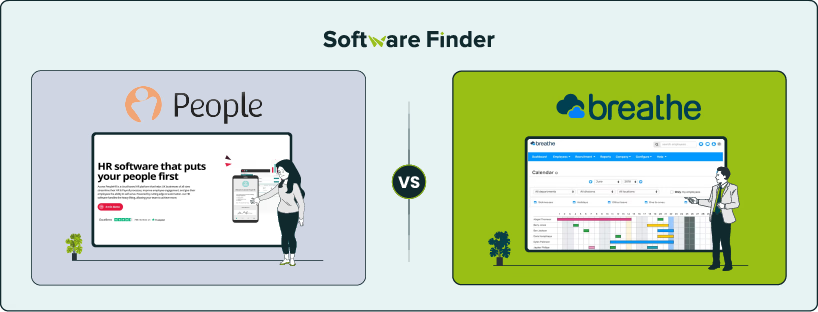
Outgrowing your HR software isn’t just frustrating—it can stall a business’s growth and create chaos across hiring, onboarding, and performance tracking. According to a Gartner report, 55% of HR leaders admit that their current technology no longer meets evolving business needs. This disconnect stems from choosing a tool that wasn’t built for a company’s respective phases of growth.
Both PeopleHR and Breathe HR are built to support growing businesses, but they take very different approaches.
PeopleHR is ideal for startups and fast-growing teams that require structure, automation, and tighter control over recruitment and performance management. In contrast, Breathe HR supports growth just as effectively, but prioritizes simplicity, flexibility, and ease of use, making it a stronger fit for smaller teams.
In this guide, we’ll break down the key differences between the two, so you can decide which one aligns best with your business goals. Let's get started!
Features | PeopleHR | Breathe HR |
Payroll | Built-in payroll via Paycircle; HMRC-approved; handles tax, pensions, and statutory pay | No built-in payroll; exports data for use in systems like Xero |
Leave And Absence Management | Visual planner, TOIL tracking, Bradford scoring, multi-country support | Simple tracker, burnout tools, phased return planning, calendar sync with Google and Outlook |
Recruitment | Full ATS with job posting, AI support, video interviews, and offer automation | Optional add-on; basic job posting and invites; lacks automation and analytics |
Employee Self-Service | Web/mobile access to leave, goals, payslips (if payroll used), performance updates | Access to documents, kudos, onboarding, shared calendars, lacks payslip access |
Time And Attendance | Advanced tracking via QR, biometrics, geo-fencing, auto timesheets, and project logging | Basic TimeClock, shift planner, email reminders; no biometric or location tracking |
Pricing | Per-user model; starts at £3/user/month; HR + Payroll bundles from £6.50/user/month | Size-based pricing; starts at £22/month for 1–10 employees |
PeopleHR is a modern HR software solution designed to help businesses manage their workforce more efficiently. It is trusted by over 7,000 companies to simplify core HR tasks like recruitment, onboarding, time-off tracking, and performance management.
It works well across all industries, but logistics and warehousing companies with diverse shift patterns and distributed teams tend to see the biggest benefits. Take Willmotts Transport, for example: with staff numbers growing from 80 to nearly 300 across multiple sites, their manual HR systems quickly became unmanageable. Since switching to PeopleHR, everything from holiday requests to compliance is now automated in one place.
This clearly shows how PeopleHR helps growing companies scale their HR operations.

- Integrated Payroll: PeopleHR provides integrated payroll software and outsourcing options, allowing businesses to handle payroll entirely within the platform or delegate it
- AI-Powered Analytics And Copilot: This system offers AI-driven analytics and a Copilot feature to automate tasks, deliver actionable insights, and support decision-making
- Applicant Tracking System (ATS): It includes a built-in ATS for end-to-end recruitment management (job postings, candidate tracking, interview scheduling)
Pros
- Sends automatic email alerts to the right managers for approvals
- Reports can be exported into Excel format, making further edits and analysis easy
- Employees can quickly update their own details without involving HR
Cons
- Support tickets are often closed without resolution
- The org chart feature isn’t intuitive and doesn’t support filtered or department-specific exports
Breathe HR is a people-focused HR software designed to help small and growing businesses manage their teams more efficiently. More than 16,000 UK companies use this system to track employee absences, manage holiday requests, store employee records, and simplify everyday HR tasks.
It works well for industries such as technology, manufacturing, professional services, and retail. However, companies that struggle with manual processes and outdated systems can benefit the most from Breathe HR. For example, Tritech, a UK-based engineering firm, faced challenges with paper-based employee records and inefficient time-off tracking. After implementing Breathe HR, they quickly digitized their HR processes, improved team coordination, and significantly reduced administrative workload.
It proves that Breathe HR can, in fact, automate routine HR work as companies grow.

- Modular Add-On Approach: It allows businesses to tailor their HR system with optional modules such as ‘Learn’ (e-learning), ‘Rota, Time & Attendance,’ ‘Expenses,’ and ‘Recruitment.’ This flexibility lets organizations pay only for what they need
- Employee Wellbeing Features: Breathe’s performance tools include ‘Kudos’, enabling peer recognition and morale boosting. Employees can send short, positive messages, which are often displayed in a feed or dashboard
- Built-In E-Learning Module: The ‘Learn’ module provides over 40 ready-made courses (e.g., ‘Acceptable Internet Use,’ ‘Emotional Intelligence in Leadership’) that can be assigned to employees or departments, with progress tracking included
Pros
- Users often mention getting quick, helpful responses from the support team
- Automated alerts help keep things like performance reviews and data updates on track
- Keeps all employee records—like promotions and personal info—in one place
Cons
- The system blocks new leave requests until a previous one is cleared
- Few options to integrate with payroll software


PeopleHR offers flexible pricing depending on whether you need just the HR software or a combined HR + Payroll solution. All pricing is based on a per-user, per-month model, and every plan comes with a 14-day free trial.
HR Software Only:
- Starter: £3/user/month
- Core: £5.50/user/month
- Pro: £8/user/month
- Elite: £9.50/user/month
HR + Payroll Bundle:
- Core + Payroll: £6.50/user/month
- Pro + Payroll: £9/user/month
- Elite + Payroll: £10.50/user/month
Breathe HR uses a business-size-based pricing model instead of charging per user. Plans scale based on employee count, and a 14-day free trial is available. You can also purchase optional add-ons separately.
- Micro (1–10 employees): £22/month
- Starter (11–20 employees): £39/month
- Regular (21–50 employees): £89/month
- Pro (51–100 employees): £159/month
- Premium (101–150 employees): £369/month
- Plus (151–200 employees): £525/month
- Add-ons (1–10 employees): Rota (£10), Learning (£12), Recruitment (£21), Expenses (£12)
Disclaimer: The pricing is subject to change.
With a score of 3:1 in favor of PeopleHR, it takes the lead as the more complete HR platform—offering built-in payroll, automated recruitment, and advanced time tracking that scales with growing teams.
That said, the better choice still depends on what your team needs right now. If you're a small business looking for simplicity, ease of use, and a clean self-service experience for your employees, Breathe HR is an excellent fit. However, if you require a system that supports structured HR processes, in-depth reporting, and long-term scalability, PeopleHR is the better investment.
If you're still weighing your options, you may also want to explore other HR tools, such as BambooHR or HiBob, each offering a distinct mix of simplicity, structure, and scalability.
